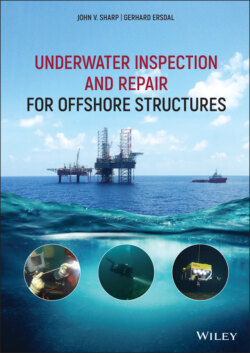Читать книгу Underwater Inspection and Repair for Offshore Structures - Gerhard Ersdal - Страница 42
2.6 Discussion and Summary
ОглавлениеAs shown in this chapter, the first standards and recommended practices relating to structural integrity management were developed in the late 1960s and early 1970s. These standards were in practice inspection standards and often included inspection plans based on routine intervals inspired by ship rules. The parts of the structures that were regarded as major or important were inspected typically every fifth year. The offshore industry began to consider more cost‐effective and optimised inspection strategies in the late 1980s and methods for condition‐based and risk‐based inspection planning were developed and started to be used in practice. A broader view on integrity management was included in the development of the international standard ISO 19902 (ISO 2007), which commenced in 1993 and included a section on structural integrity management in early drafts. This standard was first issued in 2007, but the early drafts were used as the basis for structural integrity management in the interim. The process of inspection, data management, evaluation of findings and assessing the safety of the structure were included.
HSE report RR 684 (HSE 2009) states that an inspection strategy should be:
consistent with the structural integrity strategy and SIM processes including structural evaluation, assessment, maintenance and information management requirements;
able to determine with reasonable level of confidence the existence and extent of deterioration, defects and damage;
able to address the motives for inspection listed by ISO 19902 (ISO 2007);
developed and maintained by a competent person, using appropriate experience, data and, where required, analysis
able to specify the tools and techniques to be used; and
documented.
The report (HSE 2009) further states that an inspection programme should be developed from the integrity management policy and strategy. It requires schedules, budgets, personnel profiles, inspection procedures for implementation. Guidance on developing an inspection programme is given in ISO 19902 (ISO 2007) and API RP‐2SIM (API 2014b).
A structural integrity management framework is proposed as shown in Figure 10, based on what the authors consider to be the best practice from the various standards reviewed in this chapter. Each element of the process is to varying degrees included in each of these standards and recommended practices. Inspection is a major feature of “as‐is surveillance” and repair is a key factor in “mitigating measures”.
Most standards in detail include the middle “as‐is surveillance” process with the six sub‐processes and also include guidance on “integrity assessment” and “mitigation measures”.
However, very few of the standards give guidance on hazard identification and establishing the risk picture of the structure and marine system. Two exemplary exceptions are API RP 2MIM (API2019b), which includes an annex on “causes of failure” and API RP 2FSIM (API 2019a), which includes an annex on “Damage and failure modes”, both with valuable information for hazard identification and risk management.
Many standards and recommended practices also implicitly include information and guidance on operational limitations, such as the design events, the size of vessels assumed to be visiting the platform and the importance of knowing the weight of the topside and the inventory. However, the standards and recommended practices do not necessarily give guidance on its importance for the operation of the platform or how to operate in situations outside the operational limitations. For floating structures, several relevant issues are often included in the marine operational manual.
Emergency preparedness and emergency response planning should be performed for reasonably foreseeable situations that may occur in normal and in severe conditions. This seems to be an area where the structural and marine engineers rely on the traditional emergency response discipline to understand structures and marine systems. As a result, only one standard is providing guidance on this topic. This exemplary exception is API RP‐2MIM (API 2019b), which includes an annex on “incident response planning”.
As a result, it can be concluded that for some of the important factors, the standards and recommended practices have limited information. This book attempts to bridge these gaps.
